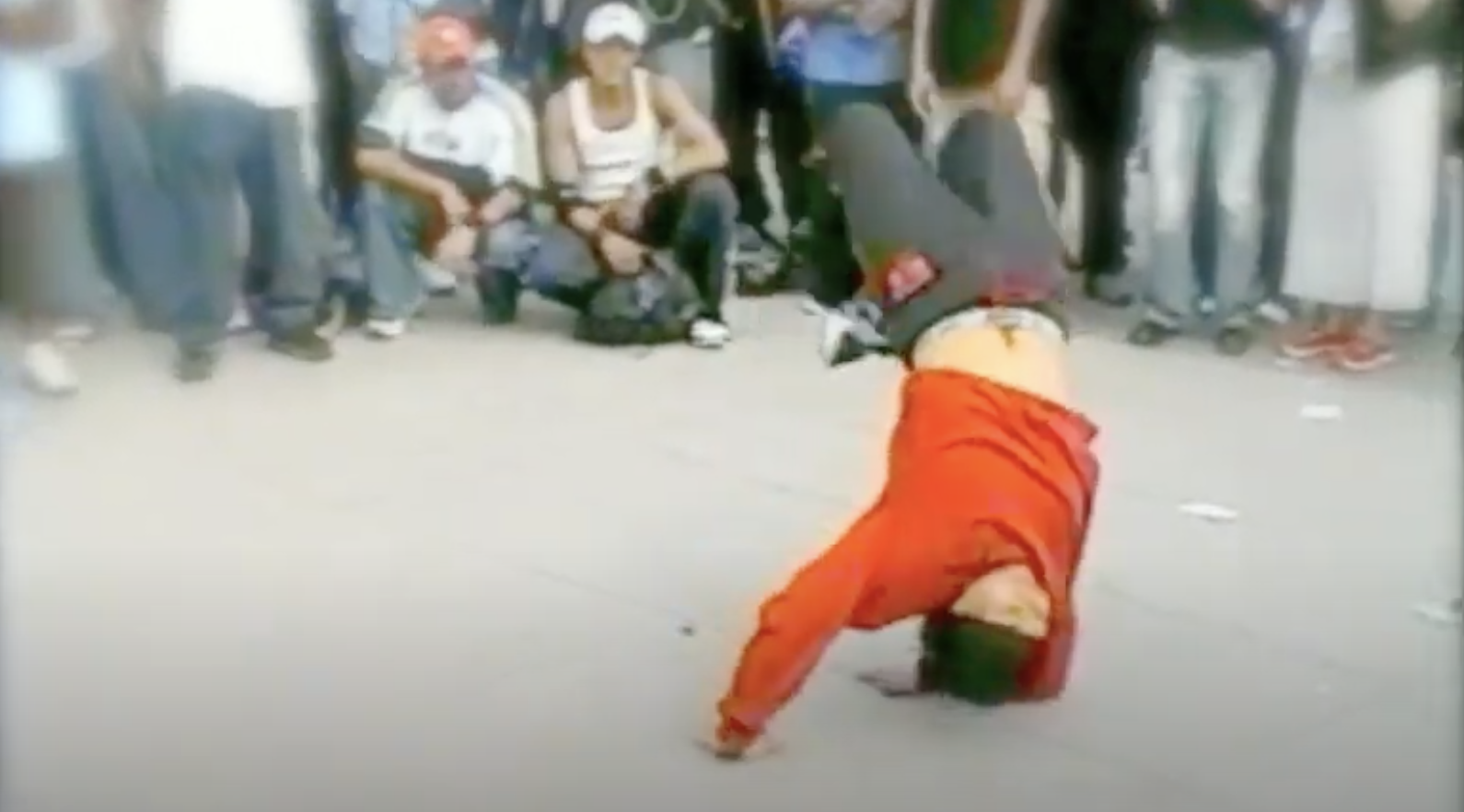
Tara Shafa
April 14, 2025

Film still from DEMF/MOVEMENT 2003 - A Stringz View featuring Mary "BGIRL MAMA" Mar. https://www.youtube.com/watch?v=QlbK1sr43C0&t=375s
It’s hard not to feel lucky to exist early in a musical genre’s timeline. With the birth of techno occurring almost half a century ago, we as clubbers and fans of techno have a rare opportunity to engage with this genre’s pioneers, many of whom are still among us. However, as most discussions about techno history tend to center on the musicians and DJs behind the decks, we often overlook the larger forces that shape the culture; it’s time to shift our attention to the dancers, the voyeurs, the bartenders, the door attendants, the designers – all techno enthusiasts who play a crucial role in sustaining and evolving the scene.
In preparation for my pilgrimage to Detroit for Movement, formerly known as Detroit Electronic Music Festival (DEMF), I asked my friend Kels for insight on what to anticipate and how best to cover the weekend. “Why are you writing this article?” they asked me, and it was just the check I needed. Kels has grown into themself within Detroit’s techno community, spending 14 years on the dancefloor before their foray into deejaying. Admittedly, their question caught me off guard – the dance music scene is known for being open and inviting, but I immediately understood why Kels was protective. Detroit, as a city, has historically been subject to exploitation in nearly every aspect of its existence. That same exploitation is exactly what gave birth to techno. As someone unfamiliar with the city beyond historical knowledge and a handful of local artist friends, I had to seriously reflect: Why me?
Though I’ve been immersed in the music scene for about a decade, I still feel like a sophomore. Miami, Chicago, and NYC shaped my club experiences, but Detroit has always felt like my final frontier in the American club landscape. The rising artists I know from the Motor City seem to exist in the year 3008, always pushing boundaries and inventing new sounds. What makes Detroit’s music scene unique is its commitment to preserving history while paving the way for future artists. To be truly welcomed in, I first needed to understand not only the music but the culture that keeps Detroit techno alive.
Prior to heading to Detroit, I reached out to different clubgoers and artists who my dear friends Kels and Sarah had recommended to me. I was nervous about any potential awkwardness in translating DMs into meetings and discussions while also enjoying link-ups at the various venues across the city. On the roster was Skeez, Crystal Mioner (DJ Etta), Gehrik Mohr, and, after a deep YouTube hole this winter, Mary “BGIRL MAMA” Mar. I wanted to hear the opinions of those who had been attending Movement Festival since its beginning in 2000 while bringing to light what the future generation of DJs had planned in order to carry on the legacy of the Detroit dancefloor. I began with an in-the-field mentality but very quickly realized that any attempts to have these conversations at the festival and at the clubs were nearly impossible.
My first stop upon landing at DTW was at MotorCity Wine. There, I was able to meet Skeez and Gehrik Mohr, who, upon messaging before my flight, responded to my inquiry with, “I’m old and brutally honest. You sure you want the REAL story?” He ended up so deep on the dancefloor that I didn’t even have a real chance to discuss his history. I chatted with Skeez a little bit, but due to the chaotic and transient nature of Movement weekend, she was already heading out to hit the next spot. I realized it was going to be a weekend of learning through doing, not talking.
Skeez, an early attendee of Movement, recalls the festival’s beginnings and how the party scene has expanded dramatically over the years to what it is today: “I went to the first Movement and have only missed one or two since. The after-party scene was different back then – it wasn’t as structured as it is now. Friends would come from out of town, get hotel rooms, and the party would often continue there. The second year, we hosted an Okayplayer reunion and held events all over the city while attending the festival. Now, you can’t throw a rock without hitting a day-party, an after-party, or a 72-hour nonstop rave. The dynamics have shifted, but it’s a natural progression.”
One of the most significant differences Skeez notes is how technology – or the lack of it – shaped dancefloor interactions. Before smartphones, the focus was purely on the music and the moment. “People vibed in their own groups, met new friends, ignored the DJ, or stood dead center in front of the speaker walls. There were fewer inhibitions. Without a camera permanently attached to your hand, you didn’t worry about being captured in a wild moment – you just let go.”
BGIRL MAMA, a breakdancer who began attending the festival in 2001, offered another perspective, reflecting on the raw energy of those early years: “I was only a few months into my breaking journey when I first went to DEMF, and back then, the festival was ‘free.99’ – which was amazing! I wish it still was. There were so many dancers from the street and hip-hop community – jitters, breakers, poppers – just taking over. I remember seeing breakers roll in with a whole linoleum floor, like, ‘Yep, we came prepared!’ And people? They were bringing in huge coolers of food and drinks like it was one big outdoor party. It just had this raw, unfiltered energy – music, movement, and people vibing together. I miss those days!”
The digital age has fundamentally altered the way we interact on the dancefloor. Today, smartphones, social media, and the need for documentation have changed how people engage with music and each other. Crystal Mioner, a young Detroit DJ under the alias “DJ Etta,” apprentice of John Collins and Rick Wilhite, and a successful nightlife organizer who started attending Movement in 2017, observes: “As long as I’ve been dancing, there have been pockets of dancers and pockets of gawkers. But since the pandemic, I’ve noticed an increase in people wanting to be seen rather than just losing themselves in the music. The DJ booth has become a focal point of attention, and interactions with strangers feel different – sometimes more guarded.”
With the rise of smartphones, dancefloors have become more surveilled. Club photography used to be the primary means of capturing nightlife, with photos posted days later on online event pages. Even before that, there would maybe be photos captured and developed for personal keepsakes. Now, people livestream, take selfies, and record videos, shifting the energy from participation to observation.
BGIRL MAMA also notes a shift in dance styles at the festival: “The biggest change I’ve noticed? The types of dancers at the festival. Back in the 2000s, there were tons of Detroit jitters and breakdancers in the cyphers – it felt like it was our space. But as the ticket prices kept going up, I started seeing fewer street dancers. Now, shuffle dancers have kind of taken over the circles. They’re super talented, and I respect the skill, but it’s just not the same energy. Back when the festival was still free (or at least affordable for the weekend), the cyphers were packed with breakers and jitters, and it felt electric: dozens of dancers just going off, feeding off each other’s energy. It felt so free. Now? It’s more shuffle-heavy, and while there are still house dancers holding it down, there are way fewer breakers and jitters than before. It’s just a different vibe.”
Despite witnessing all of these changes at the club during any regular weekend back home, every party and festival-goer seemed honed in on the music and the dancefloor during my time in Detroit. At the festival, there were people of all ages dancing, grooving, and bopping either right by each stage or out on the sidelines. The music was so good, so intense, I really didn’t have any choice but to do what I love doing as well – dancing. At the parties surrounding the festival, I met online mutuals based in Detroit for the first time, saw friends from all over the country, and had the pleasure of meeting more local artists and musicians whose dedication to their various crafts continues to amaze me.
In discussing what the future could look like, I noticed a recurring theme: “The love. The support. That feeling of community,” replied BGIRL MAMA when asked about what behaviors she hopes to see carried on by newer generations. “I wish for more kindness, more encouragement, and more moments of just enjoying the music and dancing together. Isn’t that what festivals are really about? To have a good time, to connect with other music lovers and dancers, and to create memories that stick with you for years. The energy, the love, the freedom of expression – I hope that never fades.” When I asked Skeez, she voiced a similar response to BGIRL MAMA’s: “A general sense of community and respect while radically participating on the dancefloors is something that should live forever. Allowing bodies of all abilities to live in the moment and dance like no one is watching.” DJ Etta, in response, aims to continue “pushing the music forward” and reach “new frontiers.”
While the world continues to change around us, and while we continue to adapt to change, it is obvious that community remains coveted by individuals of all backgrounds. Each generation has experienced different cultural hardships and advances, and it seems we all want to help each other with either learned wisdom or visions for the future. Music and dance have been integral parts of culture since the early days of humanity. Techno has helped Detroiters face various hardships presented by their own government and has inspired countless people from all over the globe to come together and grow during a time where the system aims to encourage individuality and de-emphasize community. Dance will remain not just a form of expression but a healthy release from the various traumas we experience daily. Humans have paved the way, are paving the way, and will continue to pave this journey we are all experiencing on the dancefloor.
Edited by Kellen MacGregor